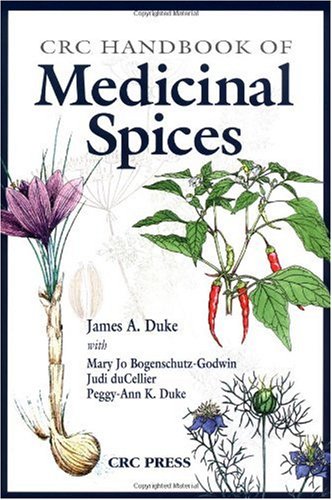James A. Duke9780849312793, 0-8493-1279-5
Table of contents :
Front Cover
……Page 1
Copyright Info……Page 3
Acknowledgments……Page 4
The Author……Page 5
Contents
……Page 6
Introduction……Page 7
Format……Page 9
Chemistry……Page 10
Dateline — Spice Timetable……Page 12
Antisepsis……Page 16
Spice Statistics……Page 17
Anise……Page 20
Capsicums……Page 21
Cardamoms……Page 22
Cassia and Cinnamon……Page 23
Cloves……Page 24
Fennel……Page 25
Laurel……Page 26
Marjoram……Page 27
Nutmeg……Page 28
Parsley (Advanced)……Page 29
Poppyseed……Page 30
Saffron……Page 31
Tarragon……Page 32
Vanilla……Page 33
Abbreviations……Page 35
Aframomum melegueta K. Schum. (Zingiberaceae)……Page 38
Aframomum sceptrum (Oliv. and D. Hanb.) K. Schum. (Zingiberaceae)……Page 41
Allium cepa L. (Liliaceae)……Page 42
Allium sativum L. (Alliaceae)……Page 50
Alpinia galanga (L.) Sw. (Zingiberaceae)……Page 60
Alpinia officinarum Hance (Zingiberaceae)……Page 63
Amomum aromaticum Roxb. and Amomum subulatumRoxb.(Zingiberaceae)……Page 67
Amomum compactum Soland. ex Maton (Zingiberaceae)……Page 68
Apium graveolens L. (Apiaceae)……Page 71
Armoracia rusticana P. Gaertn. et al. (Brassicaceae)……Page 76
Bixa orellana L. (Bixaceae)……Page 81
Boswellia sacra Flueck. (Burseraceae)……Page 84
Capparis spinosa L. (Capparaceae)……Page 89
Capsicum spp. L. (Solanaceae)……Page 93
Carum carvi L. (Apiaceae)……Page 99
Ceratonia siliqua L. (Fabaceae)……Page 106
Cinchona sp. (Rubiaceae), C. pubescens (Vahl), and C. calisaya (Wedd.), formerly C. officinalis (………Page 109
Cinnamomum aromaticum Nees (Lauraceae)……Page 113
Cinnamomum verum J. Presl (Lauraceae)……Page 118
Cocos nucifera L. (Arecaceae)……Page 123
Commiphora myrrha (Nees) Engl. (Burseraceae)……Page 127
Costus speciosus (J. König) Sm. (Costaceae. Also placed inZingiberaceae)……Page 130
Crocus sativus L. (Iridaceae)……Page 133
Cunila origanoides (L.) Britton (Lamiaceae)……Page 138
Curcuma longa L. (Zingiberaceae)……Page 141
Curcuma xanthorrhiza Roxb. (Zingiberaceae)……Page 149
Curcuma zedoaria (Christm.) Roscoe (Zingiberaceae)……Page 152
Cymbopogon citratus (DC.) Staph (Poaceae)……Page 154
Dipteryx odorata (Aubl.) Willd. (Fabaceae)……Page 159
Elettaria cardamomum (L.) Maton (Zingiberaceae)……Page 163
Eryngium foetidum L. (Apiaceae)……Page 167
Ferula assa-foetida L. (Apiaceae)……Page 170
Gaultheria procumbens L. (Ericaceae)……Page 174
Glycyrrhiza glabra L. (Fabaceae)……Page 177
Hibiscus sabdariffa L. (Malvaceae)……Page 185
Illicium verum Hook. f. (Illiciaceae)……Page 189
Juniperus communis L. (Cupressaceae)……Page 192
Kaempferia galanga L. (Zingiberaceae)……Page 197
Laurus nobilis L. (Lauraceae)……Page 199
Lindera benzoin (L.) Blume (Lauraceae)……Page 205
Moringa oleifera Lam. (Moringaceae)……Page 209
Murraya koenigii (L.) Spreng. (Rutaceae)……Page 213
Myristica fragrans Houtt. (Myristicaceae)……Page 216
Myrtus communis L. (Myrtaceae)……Page 222
Nigella sativa L. (Ranunculaceae)……Page 226
Osmorhiza spp. (Apiaceae)……Page 231
Persea americana Mill. (Lauraceae)……Page 234
Peumus boldus Molina (Monimiaceae)……Page 238
Pimenta dioica (L.) Merr. (Myrtaceae)……Page 242
Pimenta racemosa (Mill.) J. W. Moore (Myrtaceae)……Page 245
Piper auritum Kunth. (Piperaceae)……Page 248
Piper nigrum L. (Piperaceae)……Page 250
Pistacia lentiscus L. (Anacardiaceae)……Page 258
Prunus dulcis (Mill.) D. A. Webb (Rosaceae)……Page 260
Rhus coriaria L. (Anacardiaceae)……Page 265
Sassafras albidum (Nutt.) Nees (Lauraceae)……Page 267
Schinus terebinthifolius Raddi (Anacardiaceae)……Page 271
Sesamum indicum L. (Pedaliaceae)……Page 273
Syzygium aromaticum (L.) Merr. and L. M. Perry (Myrtaceae)……Page 277
Tamarindus indica L. (Caesalpiniaceae)……Page 282
Theobroma cacao L. (Sterculiaceae)……Page 286
Trigonella foenum-graecum L. (Fabaceae)……Page 291
Vanilla planifolia Jacks (Orchidaceae)……Page 297
Wasabia japonica (Miq.) Matsum. (Brassicaceae)……Page 303
Xylopia aethiopica (Dunal) A. Rich (Annonaceae)……Page 305
Zingiber officinale Roscoe (Zingiberaceae)……Page 307
Reference Abbreviations……Page 317
References……Page 322
Back Cover
……Page 333

Reviews
There are no reviews yet.